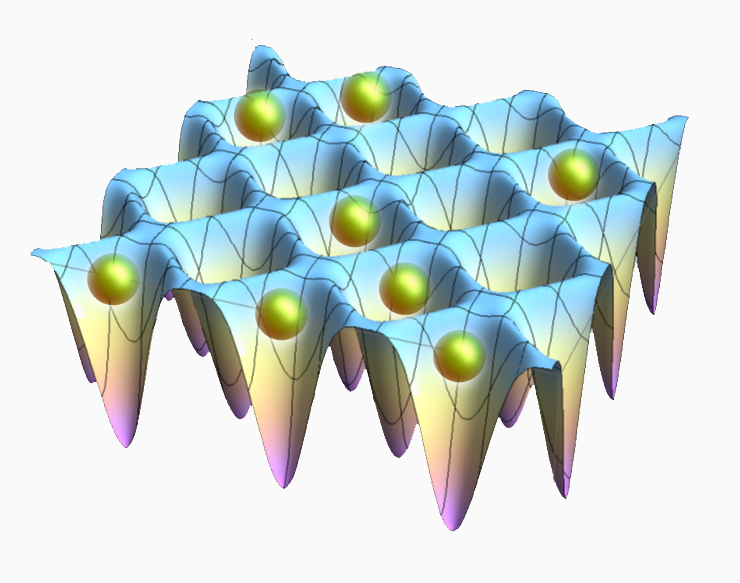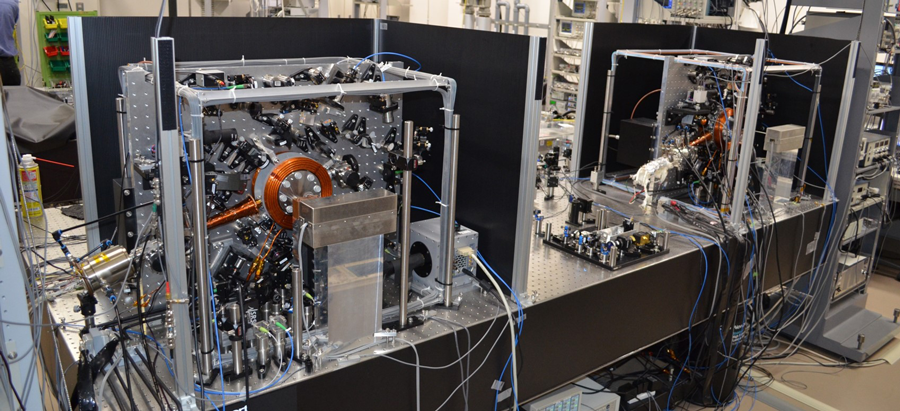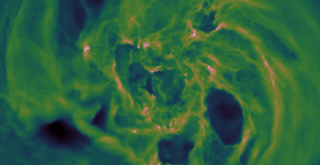And that’s what Hidetoshi Katori builds. His laboratory is filled with laser mirrors and cables, all designed to operate clocks, called “optical lattice clocks,” which are so phenomenally precise that it would take 16 billion years—longer than the universe has existed so far—for two to go out of synch by a single second. The science is pretty complicated, but basically it involves trapping a single atom inside a lattice of laser beams and keeping it at a very low temperature to prevent outside interference. Then, you can get extremely precise time measurements by exciting the atom and waiting for it to decay back to the unexcited state.
So what? Obviously nobody has to be that precise with appointments.

Schematic representation of an optical lattice: interference of laser beams creates an “egg box” optical lattice in which each “cup” holds a single atom.
In fact, these clocks can be used to measure altitude. It all goes back to this German fellow who, in the early 1900s, theorized that clocks in a strong gravitational field would go more slowly than one in a weaker one. Importantly, it’s not just that the clocks would go faster—time itself would pass by faster. So this field—called relativistic metrology—proposes to use highly precise clocks to measure altitude.
So recently, Katori did work to put this system into practice. He built two optical lattice clocks and placed them thirty kilometers apart—one on the RIKEN campus in Wako, Saitama, and the other at the University of Tokyo. He installed a dedicated optical fiber to run between the two. And the two were set up so that the one in Wako—the “master”—could control the slave in downtown Tokyo. By looking at how fast they ticked, he was able to confirm the difference in altitude already measured by other means, to centimeter precision.

Future applications of the optical lattice clock: measuring the different time delays produced by varied driving routes for a motor vehicle carrying an optical lattice clock allows gravitational potential to be mapped. Anomalies in gravitational potential might indicate the presence of natural resources or other features lying hidden beneath the surface.
So what are the practical implications? Well, first, Katori has a vision of creating an “internet of clocks,” where clocks around the world could be hooked up via the internet to monitor tiny changes in elevation. If done with millimeter accuracy, which he thinks is possible, this would make it possible to sense changes in the ground when, for example, a volcano is readying to erupt.
Another possible use is to detect mysterious dark matter. Dark matter is a form of matter hypothesized to exist, but not yet detected. If the earth passed through a cloud of dark matter, it would influence the passage of time, and Katori and others think this could be detected with fantastically precise clocks.
And that’s what Hidetoshi Katori builds. His laboratory is filled with laser mirrors and cables, all designed to operate clocks, called “optical lattice clocks,” which are so phenomenally precise that it would take 16 billion years—longer than the universe has existed so far—for two to go out of synch by a single second. The science is pretty complicated, but basically it involves trapping a single atom inside a lattice of laser beams and keeping it at a very low temperature to prevent outside interference. Then, you can get extremely precise time measurements by exciting the atom and waiting for it to decay back to the unexcited state.
So what? Obviously nobody has to be that precise with appointments.

Schematic representation of an optical lattice: interference of laser beams creates an “egg box” optical lattice in which each “cup” holds a single atom.
In fact, these clocks can be used to measure altitude. It all goes back to this German fellow who, in the early 1900s, theorized that clocks in a strong gravitational field would go more slowly than one in a weaker one. Importantly, it’s not just that the clocks would go faster—time itself would pass by faster. So this field—called relativistic metrology—proposes to use highly precise clocks to measure altitude.
So recently, Katori did work to put this system into practice. He built two optical lattice clocks and placed them thirty kilometers apart—one on the RIKEN campus in Wako, Saitama, and the other at the University of Tokyo. He installed a dedicated optical fiber to run between the two. And the two were set up so that the one in Wako—the “master”—could control the slave in downtown Tokyo. By looking at how fast they ticked, he was able to confirm the difference in altitude already measured by other means, to centimeter precision.

Future applications of the optical lattice clock: measuring the different time delays produced by varied driving routes for a motor vehicle carrying an optical lattice clock allows gravitational potential to be mapped. Anomalies in gravitational potential might indicate the presence of natural resources or other features lying hidden beneath the surface.
So what are the practical implications? Well, first, Katori has a vision of creating an “internet of clocks,” where clocks around the world could be hooked up via the internet to monitor tiny changes in elevation. If done with millimeter accuracy, which he thinks is possible, this would make it possible to sense changes in the ground when, for example, a volcano is readying to erupt.
Another possible use is to detect mysterious dark matter. Dark matter is a form of matter hypothesized to exist, but not yet detected. If the earth passed through a cloud of dark matter, it would influence the passage of time, and Katori and others think this could be detected with fantastically precise clocks.







